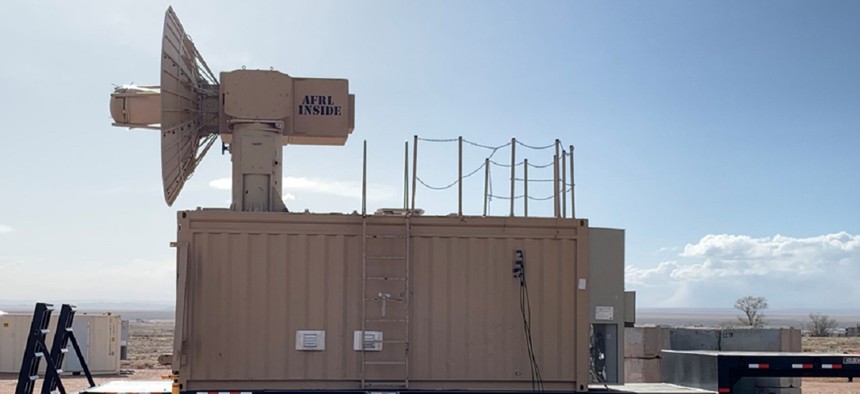Air Force Research Lab Tests Tech That Blasts Drones Down With Microwaves

U.S. Air Force
The lab is testing this new technology to combat swarms of drones and to be able to do so from a greater distance than existing counter-drone technologies.
The Air Force Research Laboratory successfully demonstrated microwave-based counter-drone swarm technology, as the dangers of such swarms continue to evolve, according to an announcement on Tuesday.
The lab demonstrated its high-power microwave counter drone weapon—the Tactical High-power Operational Responder, or THOR—technology in early April to combat several targets at the Chestnut Test Site at the Kirtland Air Force Base in New Mexico.
“The THOR team flew numerous drones at the THOR system to simulate a real-world swarm attack,” said Adrian Lucero, THOR program manager at AFRL’s Directed Energy Directorate. “THOR has never been tested against these types of drones before, but this did not stop the system from dropping the targets out of the sky with its non-kinetic, speed-of-light High-Power Microwave, or HPM pulses.”
According to the lab, THOR provides high power microwaves to create a counter-electronic effect. After a target is identified, THOR—which draws power from a standard wall plug—silently discharges the focused energy beam in a nanosecond to instantaneously disable drones. It can provide non-kinetic defeat of multiple targets.
“THOR was extremely efficient with a near continuous firing of the system during the swarm engagement,” Capt. Tylar Hanson, THOR deputy program manager, said. “It is an early demonstrator, and we are confident we can take this same technology and make it more effective to protect our personnel around the world.”
“THOR was exceptionally effective at disabling the swarm with its wide beam, high peak powers and fast-moving gimbal to track and disable the targets,” Lucero said.
Capt. Eric Plummer, a test engineer with AFRL’s Directed Energy Directorate, operated and aimed THOR at the drone swarm.
While there are other counter drone technologies like guns, nets and lasers, THOR will “extend the range to effect and decrease the engagement time over these other deterrent devices,” according to the lab.
AFRL noted that THOR is stored in a 20 foot transport container and can be moved in a C-130 aircraft. THOR can be set up within three hours and runs on a user interface designed to need minimal user training. It cost approximately $18 million to develop THOR, which is intended to protect air bases.
“We couldn’t have come this far without the perseverance and professionalism of the entire THOR team,” said Ken Miller, AFRL’s high power electromagnetics division chief. “AFRL is committed to developing such advanced technologies to defend our service members on the front lines.”




